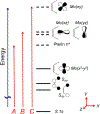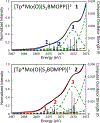Implications of Pyran Cyclization and Pterin Conformation on Oxidized Forms of the Molybdenum Cofactor
- PMID: 30200760
- PMCID: PMC6542470
- DOI: 10.1021/jacs.8b05777
Implications of Pyran Cyclization and Pterin Conformation on Oxidized Forms of the Molybdenum Cofactor
Abstract
The large family of mononuclear molybdenum and tungsten enzymes all possess the special ligand molybdopterin (MPT), which consists of a metal-binding dithiolene chelate covalently bound to a pyranopterin group. MPT pyran cyclization/scission processes have been proposed to modulate the reactivity of the metal center during catalysis. We have designed several small-molecule models for the Mo-MPT cofactor that allow detailed investigation into how pyran cyclization modulates electronic communication between the dithiolene and pterin moieties and how this cyclization alters the electronic environment of the molybdenum catalytic site. Using a combination of cyclic voltammetry, vibrational spectroscopy (FT-IR and rR), electronic absorption spectroscopy, and X-ray absorption spectroscopy, distinct changes in the Mo≡O stretching frequency, Mo(V/IV) reduction potential, and electronic structure across the pterin-dithiolene ligand are observed as a function of pyran ring closure. The results are significant, for they reveal that a dihydropyranopterin is electronically coupled into the Mo-dithiolene group due to a coplanar conformation of the pterin and dithiolene units, providing a mechanism for the electron-deficient pterin to modulate the Mo environment. A spectroscopic signature identified for the dihydropyranopterin-dithiolene ligand on Mo is a strong dithiolene → pterin charge transfer transition. In the absence of a pyran group bridge between pterin and dithiolene, the pterin rotates out of plane, largely decoupling the system. The results support a hypothesis that pyran cyclization/scission processes in MPT may function as a molecular switch to electronically couple and decouple the pterin and dithiolene to adjust the redox properties in certain pyranopterin molybdenum enzymes.
Figures














Similar articles
-
Structure and reversible pyran formation in molybdenum pyranopterin dithiolene models of the molybdenum cofactor.J Am Chem Soc. 2012 Dec 5;134(48):19584-7. doi: 10.1021/ja310018e. Epub 2012 Nov 20. J Am Chem Soc. 2012. PMID: 23157708 Free PMC article.
-
Modeling Pyran Formation in the Molybdenum Cofactor: Protonation of Quinoxalyl-Dithiolene Promoting Pyran Cyclization.Inorg Chem. 2019 Apr 15;58(8):5134-5144. doi: 10.1021/acs.inorgchem.9b00194. Epub 2019 Apr 3. Inorg Chem. 2019. PMID: 30942584 Free PMC article.
-
Identification of YdhV as the First Molybdoenzyme Binding a Bis-Mo-MPT Cofactor in Escherichia coli.Biochemistry. 2019 Apr 30;58(17):2228-2242. doi: 10.1021/acs.biochem.9b00078. Epub 2019 Apr 17. Biochemistry. 2019. PMID: 30945846
-
Advancing Our Understanding of Pyranopterin-Dithiolene Contributions to Moco Enzyme Catalysis.Molecules. 2023 Nov 7;28(22):7456. doi: 10.3390/molecules28227456. Molecules. 2023. PMID: 38005178 Free PMC article. Review.
-
The biosynthesis of the molybdenum cofactors in Escherichia coli.Environ Microbiol. 2020 Jun;22(6):2007-2026. doi: 10.1111/1462-2920.15003. Epub 2020 Apr 6. Environ Microbiol. 2020. PMID: 32239579 Review.
Cited by
-
Molybdenum Cofactor Model Reveals Remarkable Redox Activity at Both Molybdenum and the Pyranopterin Dithiolene Ligand.J Am Chem Soc. 2025 May 7;147(18):15088-15099. doi: 10.1021/jacs.4c17577. Epub 2025 Apr 27. J Am Chem Soc. 2025. PMID: 40289353 Free PMC article.
-
Resonance Raman spectroscopy of pyranopterin molybdenum enzymes.J Inorg Biochem. 2022 Oct;235:111907. doi: 10.1016/j.jinorgbio.2022.111907. Epub 2022 Jun 23. J Inorg Biochem. 2022. PMID: 35932756 Free PMC article. Review.
-
Protonation and Non-Innocent Ligand Behavior in Pyranopterin Dithiolene Molybdenum Complexes.Inorg Chem. 2022 Sep 5;61(35):13728-13742. doi: 10.1021/acs.inorgchem.2c01234. Epub 2022 Aug 24. Inorg Chem. 2022. PMID: 36000991 Free PMC article.
-
Making Moco: A Personal History.Molecules. 2023 Oct 27;28(21):7296. doi: 10.3390/molecules28217296. Molecules. 2023. PMID: 37959716 Free PMC article. Review.
-
The Impact of Ligand Oxidation State and Fold Angle on the Charge Transfer Processes of MoIVO-Dithione Complexes.Eur J Inorg Chem. 2021 Mar 12;2021(10):914-922. doi: 10.1002/ejic.202001155. Epub 2021 Jan 18. Eur J Inorg Chem. 2021. PMID: 40444014 Free PMC article.
References
-
- Kirk ML, Spectroscopic and Electronic Structure Studies of Mo Model Compounds and Enzymes In Molybdenum and Tungsten Enzymes: Spectroscopic and Theoretical Investigations, The Royal Society of Chemistry: Cambridge, UK, 2016.
-
- Kirk ML; Stein B, The Molybdenum Enzymes In Comprehensive Inorganic Chemistry II (Second Edition), Editors-in-Chief: Jan R; Kenneth P, Eds. Elsevier: Amsterdam, 2013; pp 263–293.
-
- Maia LB; Moura I; Moura JJG, Molybdenum and Tungsten-Containing Enzymes: An Overview. 2017; Vol. 5, p 1–80.
Publication types
MeSH terms
Substances
Grants and funding
LinkOut - more resources
Full Text Sources
Other Literature Sources

